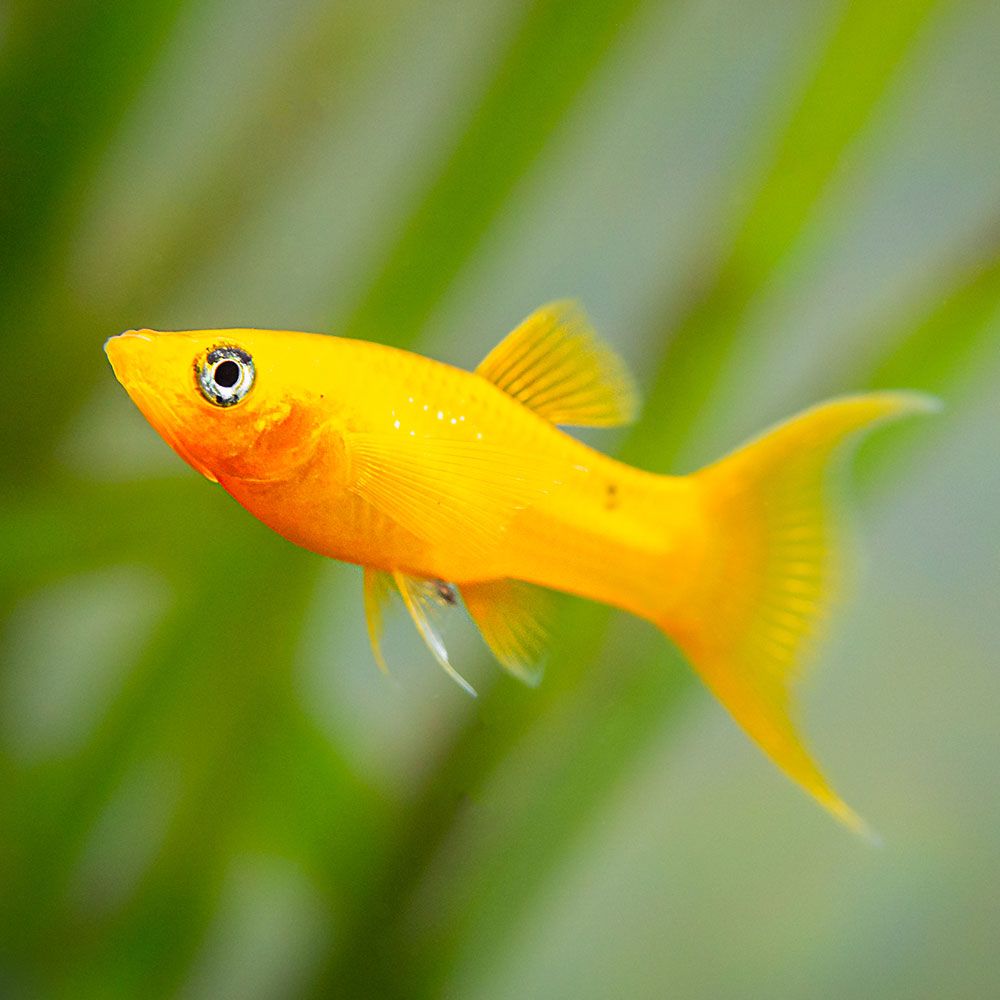If you are looking for a colorful and active fish for your freshwater tank, a shoal of molly fish might just be the best pick.
The fish is super easy to care for and gets on well with other species, making it great for peaceful community tanks. It’s also pretty easy and rewarding to breed it.
Intrigued to know more? Let’s dive right in.
What are the characteristics of Molly Fish?
| Origin | Central and South America Region, Mexico to Colombia, Costa Rica, El Salvador, Honduras, Nicaragua |
| Order | Cyprinodontiformes |
| Family | Poeciliidae |
| Scientific Name | Poecilia sphenops |
| Common Names | Molly fish, Common molly, Black molly, Mollie, Pointed-mouth molly, Mexican molly, Liberty molly, Short-finned molly |
| IUCN Red List Status | Least Concern |
| Appearance | Chunky, flat bodies, plain, silvery-gray in the wild, many have spots on their sides, backs, and dorsal fins, angular and tall dorsal fins, pointy heads, upturned mouths, curved tails |
| Size | Males: up to 8 cm (3.2 in); females: up to 12.2 cm (4.8 in) |
| Lifespan | Up to 2-5 years in captivity. Vary depending on the variants |
| Temperament | Peaceful, shoaling, non-territorial, relentless breeder |
| Tank Level | Upper and mid-water levels |
| Water Temperature | 64-82 °F (18-28 °C) |
| pH Level | 7-8.5 |
| Water Hardness | Up to 30 dGH |
| Care Level | Very easy |
| Minimum Tank Size | 40 gallons for 3-4 mollies. Add 3 gallons per extra fish |
| Tank Environment | Planted tank with rocks and caves |
| Diet | Omnivorous with carnivorous tendencies |
| Tank Mates | Peaceful and fast-moving community fish of similar size |
What is the Natural Habitat of Molly Fish?
Molly fish is native to the Central and South American regions, spanning from Mexico to Colombia. This includes Colombia, Costa Rica, El Salvador, Honduras, Mexico, and Nicaragua.
In its natural habitat, the species is found in diverse aquatic settings, including freshwater streams, coastal brackish waters, and even in some shallow marine environments like harbors and mangrove roots. It lives near the bottom of the water (benthopelagic).
The fish usually stays hidden under rocks and other structures. These social fish tend to shoal together and engage in foraging activities.
As per the IUCN Red List 2018 assessment, the molly fish species currently holds a status of Least Concern.
Did you know? Mollies are highly popular as feeder fish because of their rapid growth, birth size, prolific reproduction, and high number of viable broods.
Which family does Molly Fish belong?
The fish belongs to the family Poeciliidae under Cyprinodontiformes order. Its scientific name is Poecilia sphenops, and goes by several common names, including common molly, molly fish, black molly, liberty molly, mollie, molly, pointed-mouth molly, Mexican molly, liberty molly, and short-finned molly.
Every fish belonging to the Poecilia genus is referred to as a molly, except for guppy (P. reticulata) and Endler’s livebearers (P. wingei).
Another notable fish is referred to as molly fish in the aquarium trade – sailfin molly. Let’s know more about it here…
How does Sailfin Molly (Poecilia latipinna) look?
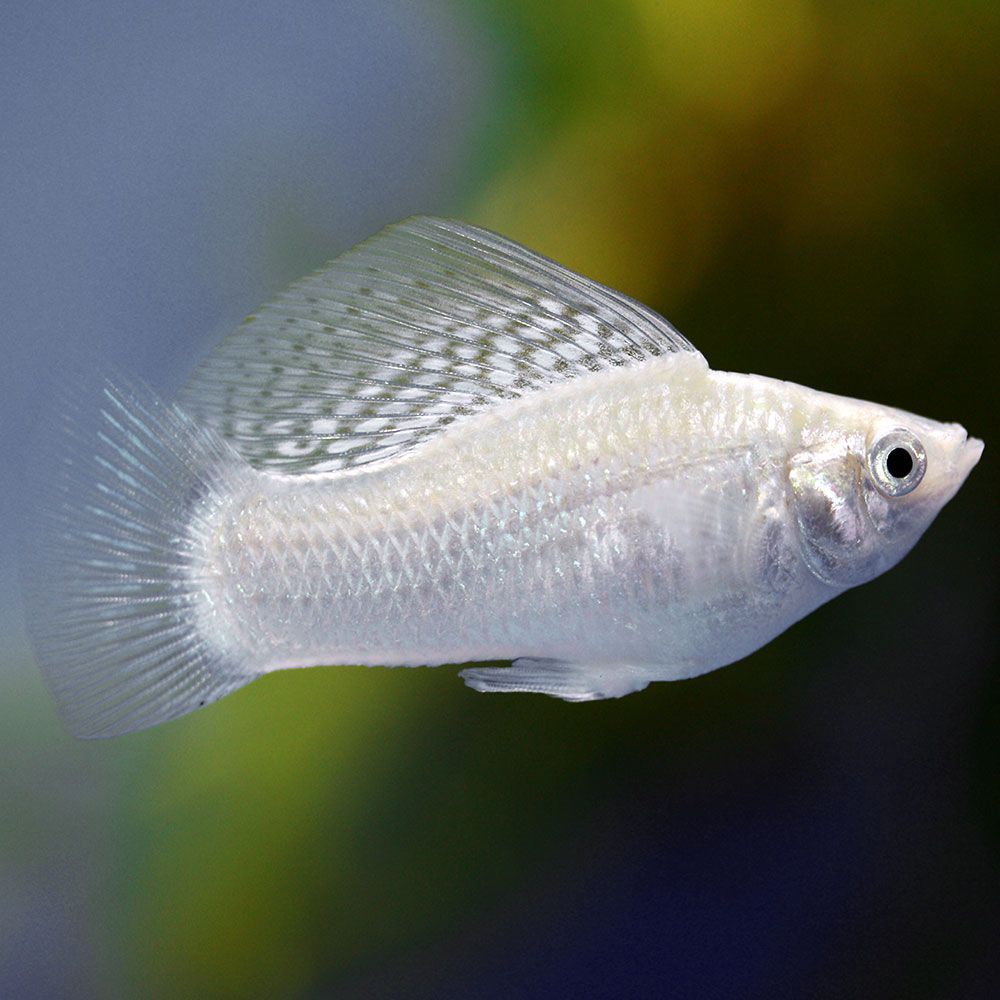
- Natural Habitat: North America: Cape Fear drainage in North Carolina, USA to Veracruz, Mexico
- IUCN Red List Status: Least Concern
- Size: Males: up to 7.6 cm (3 in), females: up to 6.4 cm (2.5 in)
- Lifespan: Up to 5 years
- Tank Level: All level
- Temperament: Peaceful
- Diet: Algaevore
- Tank Mates: Non-aggressive and similar-sized species
- Minimum Tank Size: 20 to 30 gallons for 6 fish. Extra 30 gallons per new addition
Sailfin molly has a sleek and elongated body, which makes them fast swimmers. It has big, fan-shaped dorsal fins, especially the males. It comes in various colors like silver, green, gold, black, and mixtures of these colors.
Males have a special fin called a gonopodium for mating, while females have a more triangular-shaped anal fin. Usually, males are more colorful and have longer dorsal fins than females.
Interesting Fact: Sailfin mollies can survive in oxygen-depleted waters.
How do Molly Fish look?
Now, if you want to know how the actual mollies look and behave, let’s explore it further!
What is the Size of Molly Fish?
Males typically grow to around 8 cm (3.2 in) in length, while females can reach up to 12.2 cm (4.8 in).
What is the Color of Molly Fish?
The mollies available in the wild have a plain, silvery-gray color. However, you will hardly find molly of this color in shops because most available for sale are bred in captivity and hybridized.
What are the Features of Molly Fish?
Molly fish usually has a chunky, flat body. It has rounded fins, angular and tall dorsal fins, pointy heads, upturned mouths, and a curved tail.
Some have spots on their sides, backs, and dorsal fins.
What is the difference between a male and a female Molly Fish?
While males are thinner, females are rounder and stockier, especially during reproduction.
Further, females have wider, fan-shaped anal fins that point down, while males have long, backward-pointing anal fins.
Many female mollies have a bright gravid spot where they carry their babies. Males have more vibrant colors compared to females. Sometimes, mating males turn greenish-blue.
What is the Behavior of Molly Fish in a tank?
Molly fish are social creatures that do well in their own groups. It doesn’t swim in schools, i.e., swim in a synchronized manner. Rather, it prefers to form shoals – a loose group – for social reasons.
The males relentlessly harass the females during courtship and often turn oppressive. So, house about 3 females for each male. This will protect the female from death due to exhaustion. It is a lively and active swimmer.
It also gets along with other species peacefully.
What are the Types of Molly Fish?
There are many selectively bred molly fish variants, and each of them showcases stunning colors and patterns. Let’s know about the most popular ones here.
1. Black Molly
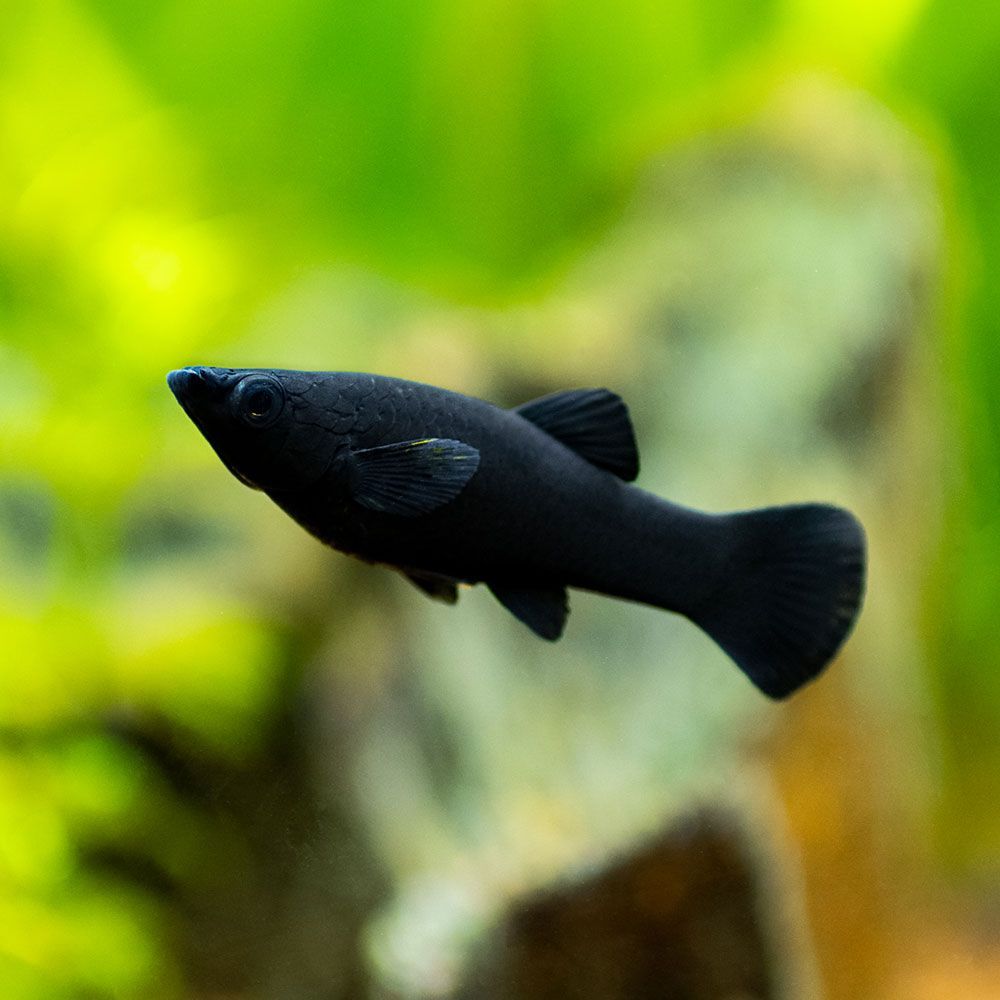
These mollies are known for their all-black bodies. Occasionally, there might be a few with a glimpse of yellow on their dorsal fins or a hint of silvery sheen on their sides.
2. Dalmatian Molly
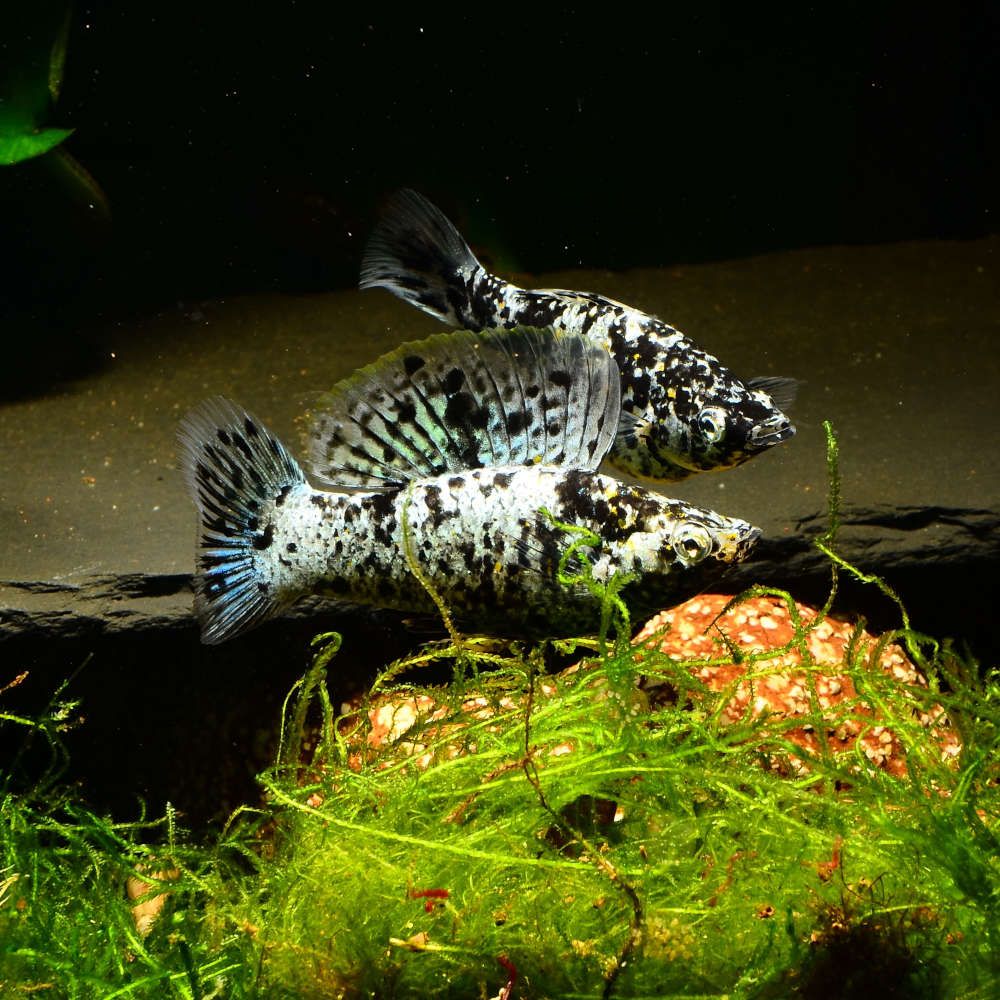
These stand out with their white or silver bodies adorned with black dots, similar to the Dalmatian dog coat.
3. Balloon Molly
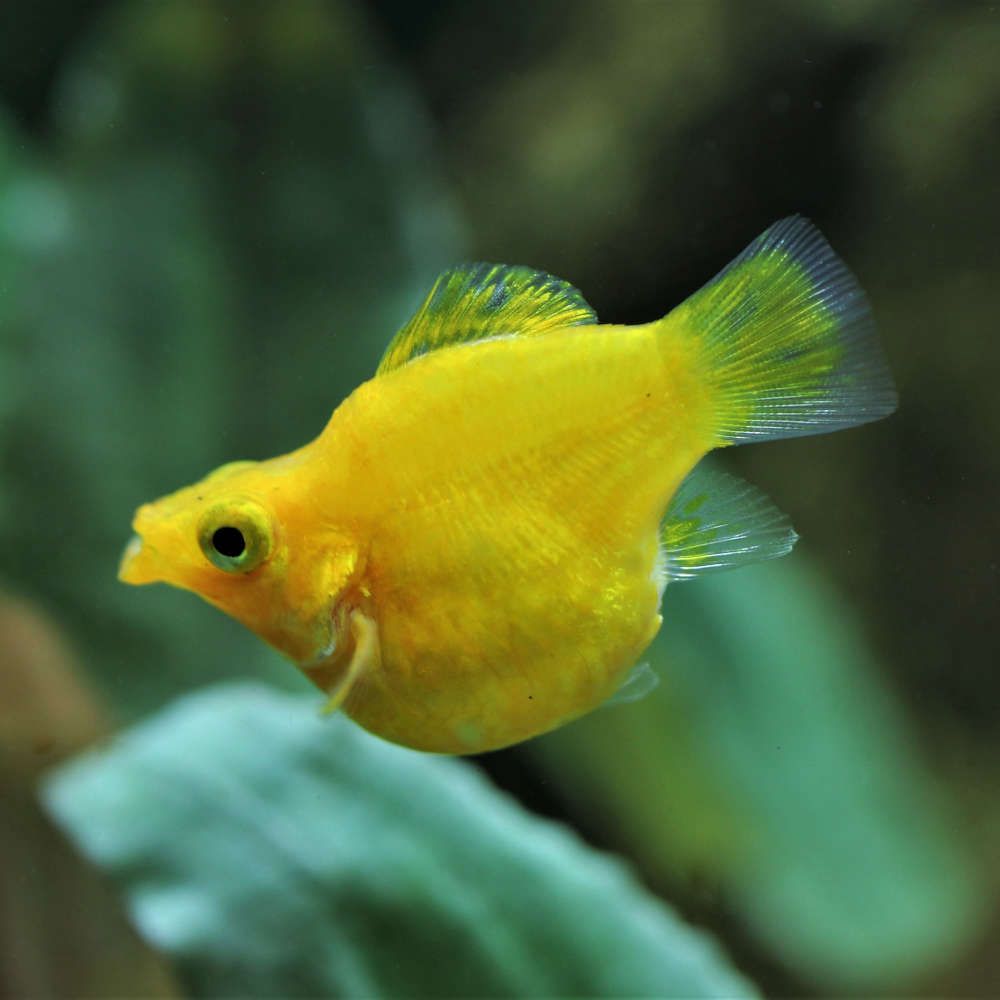
They sport plump bodies due to a genetic mutation that curves their spines. This creates a distinctive round-belly appearance. They come in various colors, from black and white to orange, silver, and yellow.
4. Gold Panda Molly

This variant has a distinctive half-black and half-gold appearance. The males feature tall dorsal fins, while the females have rounded anal fins with pregnancy spots.
5. Lyretail Molly
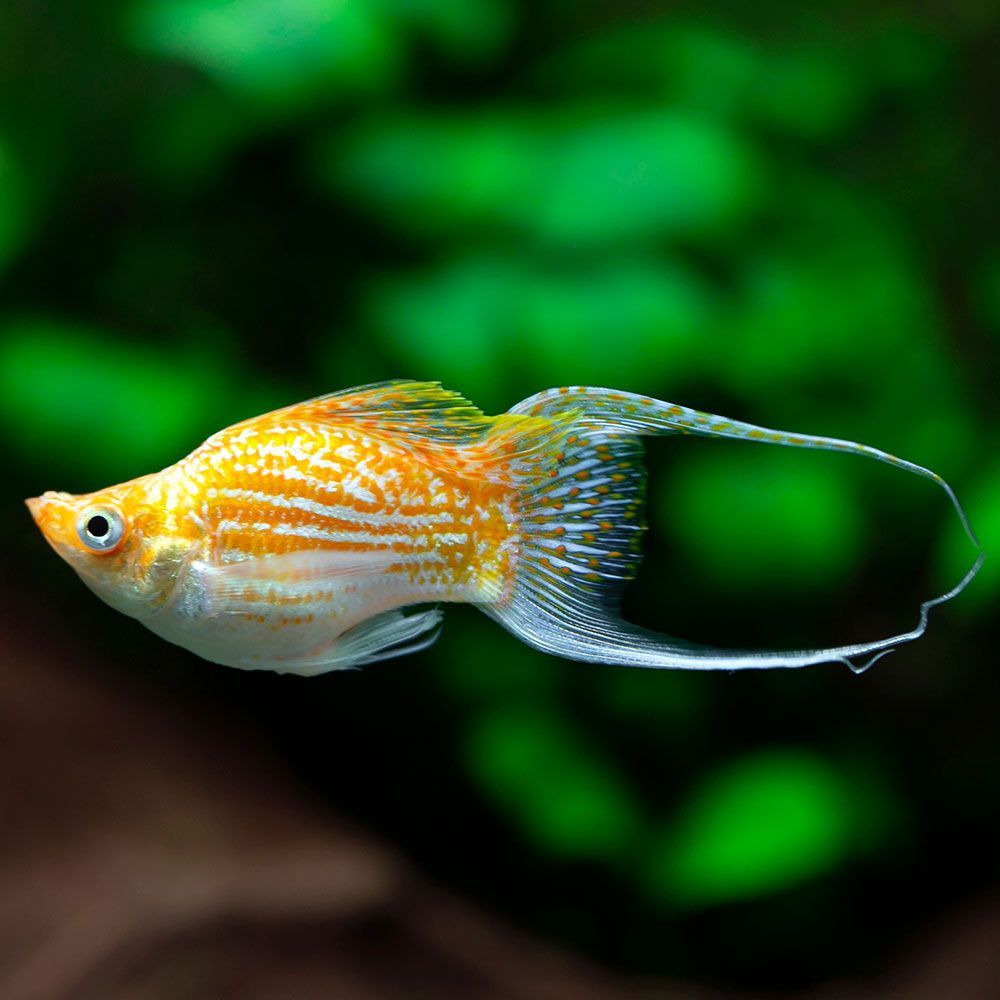
The variant has a different tail fin and comes in multiple colors, including black, silver, gold, and orange. Some have solid colors, while others combine shades. A special variant has black spots on a silver or gold background, giving them a unique look.
What is the Lifespan of Molly Fish?
The molly fish usually live for two to five years in captivity. The age of the fish also varies depending on the variant available.
In the wild, after reaching maturity, it lives for about a year.
Further, male mollies often don’t live as long as females because they’re smaller and easier for predators to catch.
Author’s Note: Mollies sometimes lose their bright colors when they are stressed. As they grow older, some might become darker or change their colors or patterns.
How to take care of Molly Fish?
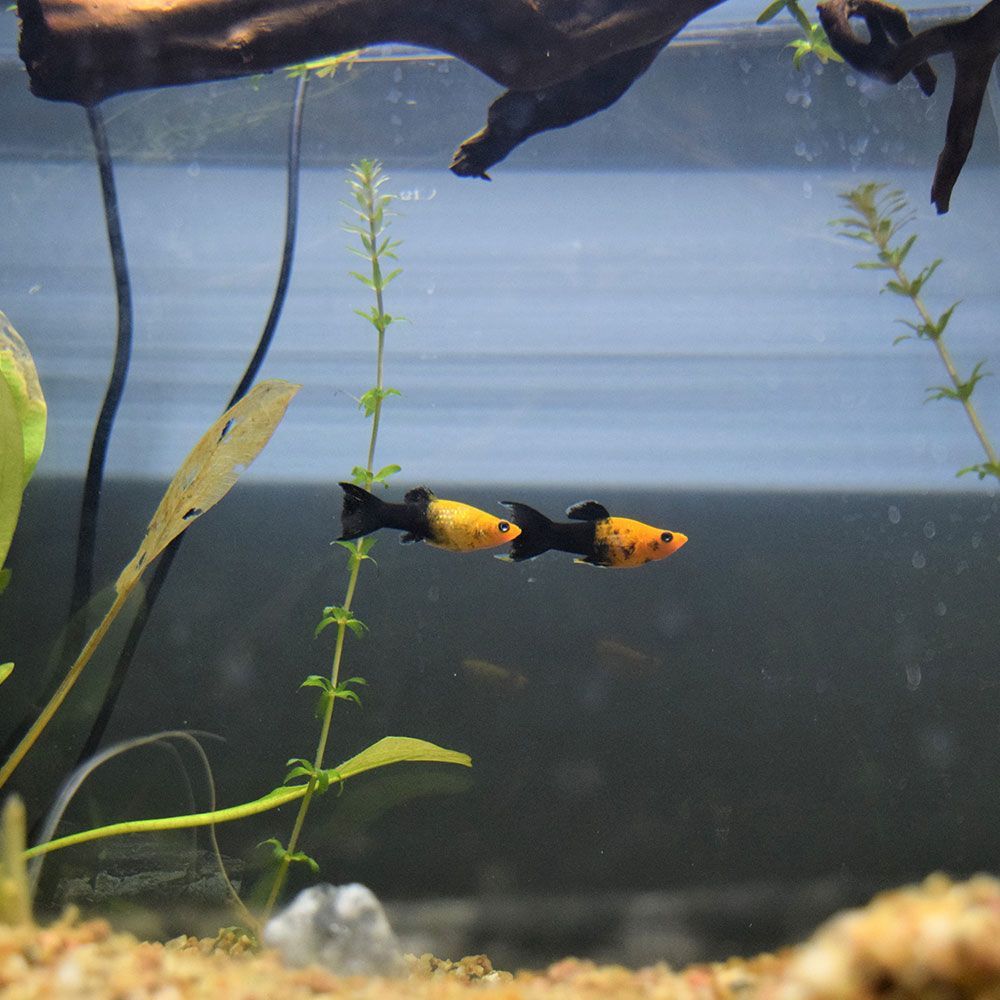
If you’re eager to add this fish to your aquarium, let’s dive into how to take good care of it!
What is the Tank Size of Molly Fish?
Since mollies are happiest in groups of three or four, you need at least a 40-gallon tank for them. For more of these, add 3 gallons per fish.
Ensure your tank is not overcrowded, as that might lead to aggression.
What is the Water Chemistry of Molly Fish?
Mollies are adaptable, but that doesn’t mean they don’t have special water preferences. Follow these general water guidelines to sustain your pet fish for the longest.
- pH Levels: 7-8.5
- Water Temperature: 64-82 °F (18-28 °C)
- Water Hardness: Up to 30 dGH
- Ammonia: 0 ppm
- Nitrite: 0 ppm
- Nitrate: Below 30 ppm
What is the Tank Environment for Molly Fish?
Next, you need to establish an environment that guarantees the safety and well-being of your molly fish. Here is your comprehensive guide to achieving this goal.
Does Molly Fish need Substrate in the tank?
Mollies like aragonite sand with calcium carbonate, which adds important minerals to their water. Crushed coral in gravel can also work.
Don’t be torn apart between the choice of substrate. They mainly swim at the top and middle of the tank, so it won’t hurt them.
The main job of the substrate is to hold up live plants. This will give the fish places to hide and enhance the aquarium’s natural ambiance.
Which Plants are required for Molly Fish?
Similar to their natural habitat, mollies prefer to swim about loose live plants for shelter. Get a mix of tall and short plants for variety. Floating plants are good since these fish like nibbling their roots.
Here are some plant suggestions:
- Vallisneria
- Sagittaria (aquatic grasses)
- Anubias
- Najas
- Java fern
- Anacharis
- Java moss
- Hornwort
- Amazon sword
- Dwarf sagittaria
- Ruffled aponogeton
Put the plants around the sides or in the corners of the tank, not in the middle where your fish swim.
What type of Lighting is needed for Molly Fish?
Molly fish is active during the day, so it prefers 8-12 hours of light each day. Use a simple timer to keep their lighting consistent.
However, they don’t need any specific intensity of light. Standard lighting is sufficient, especially to keep the live plants healthy.
What Décor is needed for Molly Fish?
Rocks, caves, branches, and other decorations that offer hiding spots are perfect decors. It may not dwell much at the bottom of the tank. But if frightened, it will at least not run out of refuge.
What is the Filtration system that is best for Molly Fish?
Molly fish creates lots of waste, so a strong filter is crucial. Get one with ample bio media capacity and consider adding an extra filter, like a sponge or internal filter.
What is the Water Flow Rate for Molly Fish?
The molly fish is accustomed to calm water and usually doesn’t prefer strong currents. But it can adapt to gentle flows. Try to keep as low current in the tank as possible.
Fish Care Tip: Molly fish can’t thrive in soft or acidic water. If it’s not naturally available, add minerals to harden the water and peat moss to make the water alkaline.
What do Molly Fish eat?
The molly fish is omnivore but greedy for carnivorous feeds. It eats tiny insects, plants, insect larvae, invertebrates, small fish, small crustaceans, and algae in the wild.
To keep it healthy in captivity, give it the same diet. Algae is their favorite, so let it grow if you can. You can feed them with the following:
- Algae wafers
- Spinach
- Lettuce
- Zucchini
- Fish pellets
- Fish flakes
- Bloodworms
- Brine shrimp
- Daphnia
Remember to feed your molly a pinch of food twice a day. Avoid overfeeding, as excess food can lead to digestive issues. Feed it a diverse diet to ensure it receives all the essential nutrients.
What are the Tank Mates for Molly Fish?
Since mollies are social fish, it’s best to start with a group of at least four of them before introducing any other fish.
The species can outcompete smaller fish for food.
So, it’s best to keep them with peaceful, similar-sized, and fast-moving community fish or fish that occupy different tank levels.
The following are a few great tank mates for this species:
- Dwarf gouramis
- Guppies
- Platies
- Neon tetras
- Cardinal tetras
- Endler’s livebearers
- Otocinclus catfish
- Zebra danios
- Siamese algae eaters
- Cory catfish
- White cloud mountain minnows
- Harlequin rasboras
- Bristlenose plecos
- Swordtails
- Tiger barbs
- Yoyo loaches
- Celestial pearl danios
- Freshwater angelfish
- Dwarf cichlids
- Keyhole cichlids
- Ram cichlids
They can also gel well with non-fish tank mates such as :
- Nerite snails
- Rabbit snails
- Trumpet snails
- Ramshorn snails
- Algae-eating crabs
Remember to ensure compatibility in terms of water parameters and tank conditions when choosing tank mates.
Which Tank Mates to Avoid for Molly Fish?
Avoid keeping mollies with these species:
- Oscars: Owing to their size and aggressive nature, Oscars can bully, injure, or stress the smaller and gentle mollies.
- Jack Dempsey fish: This aggressive species can threaten these mollies, especially when they become territorial.
- Tiger barbs: They are fin nippers, and their nippy nature may get activated by the long fins of mollies and stress them.
- Flowerhorn cichlids: The territorial, large, and highly aggressive species can stress peaceful mollies.
- Bettas: These territorial fish will attack long-finned species like mollies, and their water requirements don’t match.
- Goldfish: Goldfish prefer cooler water and can be bullied by these species, leading to injuries.
- Shrimps: Don’t keep shrimps with the omnivorous mollies, as they might try to eat them.
What are the Common Diseases for Molly Fish?
Although mollies are hardy and adaptable, they are susceptible to common freshwater diseases like ich, fin rot, and columnaris.
Other than that, there are also other diseases they might face, like the following:
| Disease Name | Causes | Symptoms | Treatment |
|---|---|---|---|
| Velvet | Parasite infection (Oodinium) | Gold cysts on the skin, darting behavior, lethargy, rubbing | Turn off tank lights, use recommended medication |
| Dropsy | Renal and liver issues, water retention due to poor water quality, and stress | Swollen appearance, protruding scales, difficulty swimming | Generally untreatable, Epsom salt baths for comfort |
| Swollen Gills | Poor water quality, ammonia or carbonate poisoning | Swollen gills, gasping for air | Water change, fasting, nitrifying bacteria |
| Protozoan | Parasitic infection, poor water quality, stress, and the presence of infected fish or contaminated equipment in the aquarium | White specks, excess slime, weakness, loss of appetite, lethargy | Maintain stable water temperature, medication, water change |
| Red Blood Spot | Ammonia or nitrite toxicity in recently cycled tanks | Red spots on the body | Prevention through proper tank cycling, immediate action in the early stages |
| Viral Haemorrhagic Septicaemia (VHS) | Viral infection | Lesions, ulcers, pale gills, bulging eyes | Antibiotics, water change |
| Swim Bladder Disorder & Inflammation | Stress or poor water conditions | Buoyancy issues, distended belly | No Treatment. Prevention through maintaining good water quality, a Balanced diet, Reducing stress, Monitoring Nitrate levels, and Quarantining new fish. Providing ample space and hiding spots. |
| Pop-Eye Disease | Bacterial or fungal infections, poor water quality, high ammonia levels, physical injury, underlying health issues. | Protruding eyes | Address the underlying cause |
| Gill Flukes | Parasitic infection | Gasping for air | Medication in early stages, quarantine for prevention |
| Camallanus Parasite | Introduced by new fish | Worms from the anus | Medication, water change, repeat treatment |
| Fish Tuberculosis | Bacterial infection | Loss of appetite, ulcers, rotting fins | Untreatable, isolate and dispose of infected fish |
| Scoliosis or Bent Spine | Genetic or disease-related | Crooked spine, trouble developing normally | No treatment. Prevention through selective breeding |
Quick Tip: Disinfect new aquarium plants to prevent diseases and parasites. Rinse, quarantine, and consider a bleach or potassium permanganate dip for a healthy tank.
How to Breed Molly Fish?
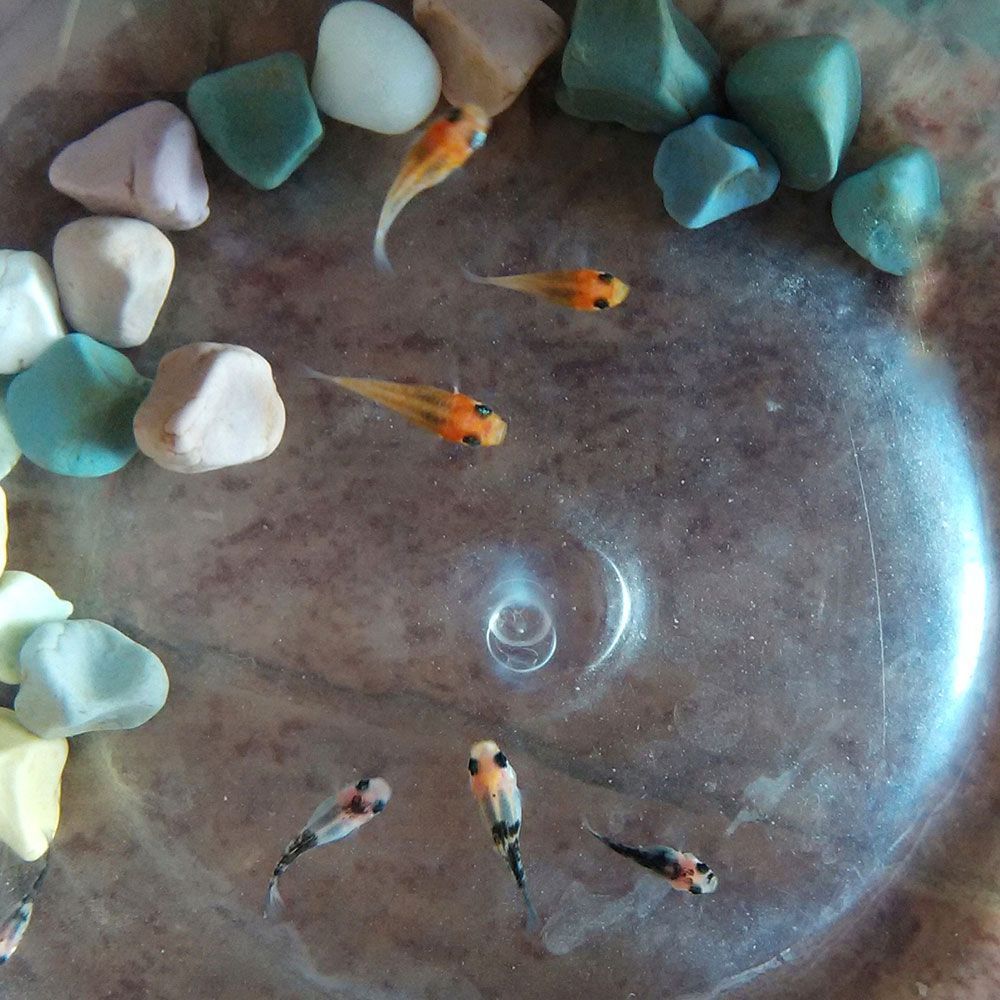
Breeding molly fish is simple and can be a fun experience. By following these steps, you can ensure a successful breeding process and the healthy growth of fry.
What is the Breeding Aquarium Set Up for Molly Fish?
While it’s not mandatory, a separate tank for breeding has its advantages. It offers a safe space for mating and protects the newborn fry from adult fish.
- Size: Select a 20-gallon tank for breeding.
- Water Conditions: Maintain a temperature of around 78°F (25-26°C) and ensure clean water.
- Substrate and Decor: Use fine gravel or sand as the substrate and provide hiding spots with plants and decorations.
- Filtration: Install a gentle filter to avoid disturbing fry.
- Lighting: Moderate lighting is sufficient.
How to Cycle the Tank for Molly Fish?
Cycle the breeding tank before introducing the fish. This establishes beneficial bacteria that break down waste. It usually takes a few weeks to complete. Use water from your main tank or a bacterial supplement to speed up the cycling process.
What are the Mating Conditions for Molly Fish?
To encourage mating, maintain a ratio of around 2 to 3 females for every male. Females typically prefer larger males. So, choose the largest male of all.
What is the Mating Ritual for Molly Fish?
Molly fish have a unique courtship ritual. The male chases and shows off its fins to attract females. Males and females swim together side by side before mating.
Fertilization in this fish occurs internally. The male transfers milt (a fluid containing sperm) into the female’s body through a specialized anal fin called a gonopodium.
What are the Signs of Pregnancy for Molly Fish?
The fish doesn’t lay eggs. They’re livebearers, which means the fry develops inside the mother’s body and is born as live fish.
Pregnant females will visibly grow in size as they carry developing fry within their bodies. They may seclude themselves once with eggs.
The female fish carry their fry inside them for about 42-45 days before giving birth.
How do Molly Fish Fry Appear?
A single female molly can have a large number of fry in one go, sometimes as many as 100 or more.
Newly born fry are tiny and need protection. Provide hiding places, like dense plants, to keep them safe from adult mollies that might prey on them.
The female fish may give birth to new fry in multiple batches. This is because she can store milt in herself for many months. So, one-time mating may lead to too many fry.
When to Separate Molly Fish Fry and Parents?
Adults might try to eat their own fry. To prevent this, it’s wise to move the parents out of the breeding tank once the fry is born.
Another way to handle this is to seclude the pregnant female fish in another tank. Once she gives birth to her fry, remove her from the tank.
Avoid using breeding nets or traps to separate newly born fry, as they are too small and can easily pass through the mesh.
How does Molly Fish Fry Develop?
Fry needs special care and food. Initially, feed them powdered fish flakes.Usually around two months old, they’re big enough to eat the adult molly food.
The fry growth can be hastened if the water is slightly warmer and well-maintained.
Breeding Tip: Always mix up your fry with other breeders’ fry or buy a new fry. Otherwise, long-term breeding within the fry from the same ancestors may lead to genetic defects and infertility.
How to Buy Molly Fish?
- Choose active and social mollies.
- Avoid fish with pale or fading colors, as this may indicate stress or illness.
- Avoid stressed ones that breathe rapidly or irregularly or gulp air.
- Avoid fish that swim erratically or appear distressed, as this can be a sign of underlying issues.
A word from FishInAquarium
It is a delight to watch a bunch of common mollies with unique fins swim around in your tank. They’re also voracious eaters, so mealtimes are always fun.
If you’ve found this article informative and inspiring, please consider sharing it with fellow enthusiasts. However, if you have more questions or need further assistance, don’t hesitate to email us!

